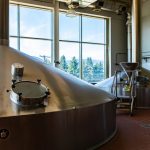Beer brewing is a fascinating and intricate process that transforms basic ingredients into the beloved beverage enjoyed by millions worldwide. This ancient art combines science, tradition, and craftsmanship to create a diverse array of beer styles, each with its unique flavor profile. The brewing process typically involves several key steps, including malting, mashing, boiling, fermenting, conditioning, and packaging.
Malting – Step 1
The brewing process begins with malting, where barley grains are soaked in water and allowed to germinate. This activates enzymes in the grains that convert starches into fermentable sugars. After a few days, the germination is halted by drying the grains using hot air in a kiln. This results in malted barley, the foundation for the beer.
Mashing – Step 2
The malted barley is then mixed with hot water in a process known as mashing. This step activates enzymes in the malt, breaking down the starches into sugars, creating a sweet liquid called wort. The temperature and duration of the mash influence the beer’s body, sweetness, and mouthfeel. Mashing takes between 20 and 30 minutes.
The mash tun (called ‘kieve’ in Ireland) is really the only vessel that is used for mashing. It is an insulated, usually jacketed vessel which is operated similarly to the mash mixer. Mash conversion and the separation of wort from spent grains occurs in this one vessel.
The mash tun has to be considered as separate from vessels used for mash mixing only and those incubation vessels where only the mash conversion is carried out. In some cases wort is collected in a separate vessel called the mash filter or lauter tun.
The clean mash tun is usually preheated to the mashing temperature with hot water and steam. .
Lautering – Step 3
After mashing, the liquid wort is separated from the spent grain husks in a process called lautering. This involves draining the wort from the mash tun, and pumping this into a different vessel known as a lauter tun. In the lauter tun, the grains are rinsed to extract any remaining sugars. The collected wort is then ready for the next step.
Boiling – Step 4
The wort is transferred to a large kettle where it is boiled and hops are added. Hops contribute bitterness, aroma, and flavor to the beer while also acting as a natural preservative. The timing and variety of hops added during the boil influence the beer’s final taste and aroma. Boiling also sterilizes the wort, removing any unwanted microorganisms.
Cooling – Step 5
After boiling, the hot wort must be rapidly cooled to a temperature suitable for fermentation. This is typically done using a heat exchanger, where cold water is circulated around the hot wort. The quick cooling helps prevent the formation of undesirable compounds and promotes the precipitation of proteins.
Fermentation – Step 6
Once cooled, the wort is transferred to a fermentation vessel, usually a fermentation tank or a traditional fermenter. Yeast is then added to the wort. The yeast consumes the sugars in the wort, producing alcohol and carbon dioxide as byproducts. This primary fermentation can take place over a period of several days to several weeks, depending on the beer style and desired characteristics.
Conditioning – Step 7
After the primary fermentation is complete, the beer undergoes a conditioning or maturation phase. During this time, the beer is left undisturbed to allow the yeast to settle and the flavors to develop. This can happen in the same fermentation vessel or be transferred to a separate conditioning vessel.
Filtration and Carbonation – Step 8
Depending on the beer style and the brewery’s preferences, the beer may undergo filtration to remove any remaining yeast or particles. The final filtration step will produce a clear and bright beer. Carbonation, the addition of carbon dioxide to create bubbles, can occur naturally during fermentation or be added later in the process.
Packaging – Step 9
The final step involves packaging the beer for distribution and consumption. Common packaging formats include bottles, cans, and kegs. Before packaging, the beer may undergo additional treatments such as pasteurization or the addition of stabilizers to ensure its stability and quality during storage.
Quality Control
Throughout the brewing process, quality control measures are implemented to ensure consistency and excellence. This includes regular testing of the raw materials, monitoring fermentation conditions, and conducting sensory evaluations of the finished product. Quality assurance practices help brewers maintain the integrity of their beer and meet the expectations of consumers.
The beer brewing process is a harmonious blend of science and art, tradition and innovation. Brewers around the world use their expertise to create a diverse range of beers, each with its unique characteristics. Whether it’s a crisp lager, a robust stout, or a hoppy IPA, the careful orchestration of these brewing steps is essential in crafting the perfect pint. As the craft beer movement continues to grow, brewers experiment with new ingredients, techniques, and styles, pushing the boundaries of what beer can be and delighting beer enthusiasts with an ever-expanding array of choices.


Leave a Reply